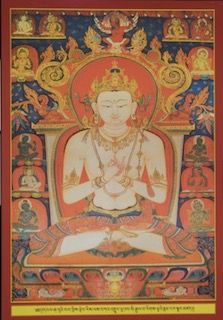Vairochana: Difference between revisions
Jump to navigation
Jump to search
mNo edit summary |
mNo edit summary |
||
| (4 intermediate revisions by 3 users not shown) | |||
| Line 1: | Line 1: | ||
'''Vairochana''' (Skt. ''Vairocana''; Tib. ''Nampar Nangdzé'' | [[image:Vairochana-1.jpg|frame|'''Buddha Vairochana''']] | ||
'''Vairochana''' (Skt. ''Vairocana''; Tib. [[རྣམ་པར་སྣང་མཛད་]], ''Nampar Nangdzé'', [[Wyl.]] ''rnam par snang mdzad''; Eng. 'Completely Manifesting') — | |||
#The chief [[buddha]] of the [[ | #The chief [[buddha]] of the [[buddha family]], ''see'' [[buddhas of the five families]]; or | ||
#The great [[Dzogchen]] master and translator, ''see'' [[Vairotsana]]. | #The great [[Dzogchen]] master and translator, ''see'' [[Vairotsana]]. | ||
[[Category:Buddhas and Deities]] | [[Category:Buddhas and Deities]] | ||
[[Category:Buddhas of the Five Families]] | |||
[[Category: Disambiguation pages]] | [[Category: Disambiguation pages]] | ||
Latest revision as of 12:31, 9 February 2019

Vairochana (Skt. Vairocana; Tib. རྣམ་པར་སྣང་མཛད་, Nampar Nangdzé, Wyl. rnam par snang mdzad; Eng. 'Completely Manifesting') —
- The chief buddha of the buddha family, see buddhas of the five families; or
- The great Dzogchen master and translator, see Vairotsana.